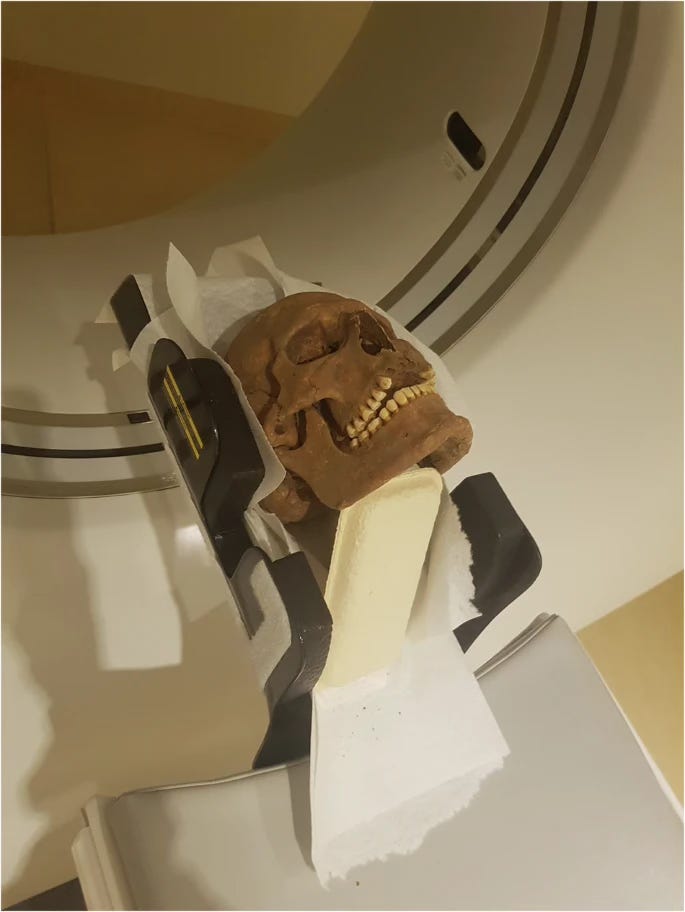Think You’d Want to Be a Viking? This Study on Their Rotting Teeth Should Change Your Mind
A New Study Reveals the Brutal State of Viking Teeth While Testing the Power of CT Scans
For years, historians believed oral health wasn’t all that bad before the introduction of cane sugar. Early populations were assumed to have relatively strong teeth and fewer cavities without modern processed foods. There was even a law in medieval England where a woman could divorce her husband for having bad breath, so we know dental hygiene was important, at least by that time. New research suggests that Viking-era Scandinavians had their fair share of dental woes long before sugar became a major culprit. A recent study using computed tomography (CT) scans on Viking-age skulls from Varnhem, Sweden, reveals a shocking truth: Vikings—at least the ones in that region—suffered from severe dental problems, including infections, decay, and jaw issues that would have made everyday life miserable.
Unveiling Viking-Age Health Through CT Imaging
Archaeological research has long relied on traditional osteological analysis, or examining bones with the naked eye under intense light, to understand past populations. However, computed tomography (CT) imaging provides a non-invasive and highly detailed view of skeletal remains, offering insights beyond what can be detected through visual inspection alone.
In an exploratory study published on 18 February 2025, researchers analyzed 15 skulls from a Viking-era Christian settlement in Varnhem, Sweden (10th–12th century AD). The goal was to determine whether CT imaging could reveal hidden pathological conditions that traditional examination methods might miss.
The study, conducted by specialists in oral and maxillofacial radiology, found a range of orofacial and skeletal conditions that suggest these individuals lived with significant discomfort if not outright suffering. Among the key findings:
1. Dental and Alveolar Conditions
Dental caries (cavities) are found in 27% of individuals, highlighting a diet that included carbohydrates, possibly from bread or porridge.
Periodontal disease (gum disease): Present in 66% of the individuals, particularly affecting molars.
Periapical inflammatory disease (tooth root infections): A whopping 80% of the examined skulls showed evidence of deep infections that would have caused pain and swelling.
Tooth loss: Several individuals had lost teeth before death, with one completely edentulous individual (no teeth left!).
2. Temporomandibular Joint (TMJ) Disorders
Over half of the individuals exhibited signs of joint degeneration, including:
Osteophyte formation (bone spurs)
Flattening of the condyle (jaw joint erosion)
Loss of cortical bone
Sclerotization (hardening of the jawbone)
These findings suggest chronic pain, arthritis, or wear from frequently chewing tough foods.
3. Chronic Sinusitis and Ear Infections
Three individuals had sinusitis indicators, which could have been linked to respiratory infections, dental infections, or environmental factors like smoky indoor fires.
One individual showed sclerotization of the mastoid process, indicating a history of chronic ear infections (otitis media)—a condition that, untreated, could have been life-threatening.
4. Other Pathologies: Trauma, Infections, and Bone Reactions
Evidence of untreated infections suggests that some individuals may have suffered from painful, even deadly, systemic infections in an era without antibiotics.
Joint deterioration and bone remodeling suggest that some may have lived with arthritis-like conditions, likely exacerbated by physical labor and diet.
Why Does This Study Matter?
While the dental and skeletal issues found in the Viking skulls may be unsettling, the true aim of the study wasn’t to catalog these conditions. They were already known from previous research. Instead, the study sought to determine whether computed tomography (CT) scans could provide deeper insights into pathologies that traditional osteological and radiographic methods might miss. By scanning 15 Viking-era skulls from Varnhem, Sweden, researchers aimed to assess whether CT imaging could reveal hidden structural changes, internal infections, and other conditions that might not be detectable through standard examination techniques.
The results strongly suggest that CT scans allow for a more detailed analysis, uncovering signs of deep infections, bone remodeling, and subtle degenerative changes that would have been difficult or impossible to observe otherwise. This confirms that CT scanning is a valuable non-invasive tool for advancing the study of ancient remains, giving archaeologists and forensic researchers a clearer window into the health of past populations.
The Study Wasn’t About Rotting Teeth, But It Certainly Shined a Light On Them
Many people have asked me if I want to go back to the Viking Age or if I wish I had lived there. We answered this on the Vikingology podcast. Some reenactors and history buffs say yes, but this study proves why that idea is terrible. Eighty percent of the skulls showed severe dental disease. Infections, abscesses, periodontal disease, and jaw deterioration plagued these people. Many suffered from chronic pain, with no way to treat it beyond crude extractions or suffering in silence. Some had bone infections that likely led to life-threatening complications. Imagine waking up daily with a raging toothache, knowing there was no cure, relief, or end. I have no interest in traveling back to that time. Without modern medicine, I would not have survived childhood. I love studying the Viking Age, but I will stay right here with my antibiotics, dentists, and painkillers.



